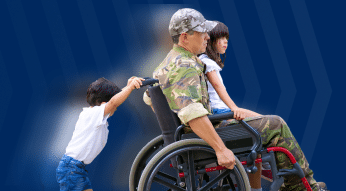Home » VA Disability Conditions List » VA Disability Rating for Restless Leg Syndrome
VA Rating for Restless Leg Syndrome
If you are a veteran with restless leg syndrome connected to your military service, you may qualify for monthly VA disability benefits. The VA evaluates your symptoms and their effects, assigning a percentage rating based on the severity of your condition. Learn more about how you can pursue a VA disability rating for restless leg syndrome and how Veterans Guide can help you get the benefits you deserve.
- Restless Leg Syndrome (RLS) in veterans can be linked to military service, with certain injuries raising the risk of developing symptoms.
- The VA rates RLS under neuritis code 8620, with disability levels ranging from 10% to 60%, based on symptom frequency, severity, and impact on daily life.
- Veterans with RLS may qualify for Total Disability based on Individual Unemployability (TDIU) if they can’t secure substantially gainful employment due to their condition.
Many veterans develop restless leg syndrome as a result of injuries and conditions related to their military service. If you have this sleep-disrupting condition, you may be eligible for monthly compensation through a VA disability rating for restless leg syndrome. Receiving the correct restless leg syndrome VA rating based on your symptoms is critical for getting the disability benefits you deserve.
Veterans Guide helps people who have served to understand the process of applying for VA disability benefits. Learn everything you need to know about benefits for restless leg syndrome, from establishing a connection to your service to navigating the VA claims process.
How Does the VA Rate Restless Leg Syndrome?
The VA grades service-connected disabilities on a scale from 0 percent to 100 percent in increments of 10 percent. Your VA disability rating corresponds to the monthly compensation amount you will receive.
Higher ratings equate to more severe conditions with greater lifestyle limitations. Eligibility for additional VA programs is also based on the disability ratings.
The VA evaluates the following factors when determining RLS disability ratings:
- Symptom frequency: How often do RLS symptoms occur?
- Severity: How profound are the sensations and urge to move?
- Impact and impairment: Effects on sleep, daily function, work, and quality of life.
- Response to treatment: Have therapies successfully relieved symptoms?
The VA does not currently have a code specific to RLS. Instead, the VA uses code 8620, a code used for cases of neuritis, which is inflammation of one or more nerves. Under code 8620, the condition can be rated at 10 percent, 20 percent, 40 percent, or 60 percent. The VA Restless Leg Syndrome disability levels and criteria based on code 8620 are:
| 10% | Mild |
| 20% | Moderate |
| 40% | Moderately severe |
| 60% | Severe symptom |
The moderately severe 40 percent rating generally requires the presence of one or more symptoms that significantly affect your body’s ability to function. The severe 60 percent level typically involves muscle atrophy, a loss of sensation, and a loss of reflexes.
Keep detailed records with dates and times of your symptoms to help your doctor and the VA determine your disability levels.
TDIU and Restless Leg Syndrome
Veterans whose service-connected disabilities make them unable to secure substantially gainful employment may qualify for Total Disability based on Individual Unemployability, or TDIU.
If approved, TDIU provides compensation at the 100 percent rate, even if your combined disability rating is less than 100 percent. To qualify for TDIU with RLS, you must show you cannot obtain or hold a steady job that financially sustains you due to your service-connected disability.
In addition, you must prove the following:
- Your service-connected RLS is rated at 60 percent.
- Alternatively, you have multiple service-connected disabilities with a combined rating of at least 70 percent, with one rated at least 40 percent.
Work history, medical records, and statements from previous employers, coworkers, friends, and family help substantiate TDIU claims. Vocational testing may also be required.
If your rating doesn’t meet the criteria for TDIU, you can try to get a rating change through the appeals process. There is also a chance that the VA Rating Board will determine that you qualify for TDIU despite not meeting the usual requirements. In these cases, the Board sends a detailed statement to the VA Compensation Service asking for extra consideration on your behalf.
How To Obtain a VA Rating for Restless Leg Syndrome
To receive a VA rating and compensation for restless leg syndrome:
You can claim benefits from the Veterans Association if you believe your military service caused your RLS. If your claim is successful, you will receive access to VA programs and monthly compensation based on your disability rating. Submit your claim in one of three ways:
- Complete the online application by yourself or with the help of an advocate.
- Complete VA Form 21-526EZ and mail it to the VA Claims Intake Center.
- Complete the VA Form 21-526EZ and bring it to your nearest VA regional office.
Include your VA and private medical records and attach supporting statements from family members, friends, people you served with, or others who can attest to your restless leg syndrome and its effects.
Also, provide any military records supporting your position, such as in-service medical records and incident reports related to your injury or condition.
The VA may ask you to take a compensation and pension, or C&P, exam before assigning you a disability rating. They require this exam when you lack sufficient evidence to support your claim.
To learn more about VA benefits for restless leg syndrome or answers to any other VA disability questions, contact Veterans Guide. We can help you navigate the process of requesting VA compensation for your restless leg syndrome.
Restless Leg Syndrome as a Secondary Disability
A secondary disability is one caused by another service-connected condition. The VA recognizes restless leg syndrome as a neurological condition that can result from injuries or illnesses incurred during military service. In particular, studies have linked RLS to post-traumatic stress disorder, or PTSD, and sleep apnea.
When you have multiple service-connected conditions, including secondary disabilities, the VA will combine the disability ratings for each to determine your final rating. This is advantageous because you can get increased compensation if rated for RLS in addition to the disability that caused it.
For example, if you have a 50 percent disability rating for PTSD and receive 30 percent for secondary RLS, your combined rating would be 70 percent based on the VA’s formula. That allows you access to greater benefits than for the 50 percent PTSD rating alone.
Veterans and Restless Leg Syndrome
Restless leg syndrome, or RLS, is a neurological disorder affecting many military veterans. Though the cause of RLS is unknown, certain injuries associated with military service, including traumatic brain injuries, spinal injuries, and vascular damage, increase veterans’ risk of developing RLS symptoms.
What Is Restless Leg Syndrome?
Restless leg syndrome is characterized by throbbing, pulling, creeping, or other unpleasant sensations in the legs and an uncontrollable, sometimes overwhelming, urge to move them. Symptoms primarily occur at night when you sit or lie down.
RLS sensations range from mild to intolerable. RLS can cause difficulty falling asleep and staying asleep, resulting in profound fatigue and impaired daily function. The disorder frequently results in insomnia. Moving the legs, walking, stretching, or massage typically provides temporary relief.
The cause of RLS is still unknown, but research points to hereditary factors and dysfunctions in dopamine production and iron metabolism. RLS symptoms can become more frequent and severe over time, especially if the disorder goes untreated.
RLS symptoms typically affect both legs but are often worse in one leg. They may only involve the feet or ankles but commonly include the entire leg up to the thigh or higher. Some people also experience symptoms in the arms, chest, head, stomach, and other body parts.
In more severe cases, RLS symptoms may begin earlier in the day, last longer, and spread beyond the legs and feet.
How Does Military Service Connect to Restless Leg Syndrome?
Approximately 5 to 15 percent of Americans suffer from RLS. However, service members and veterans have an increased risk of developing the disorder due to injuries sustained during active duty. Traumatic brain injuries, spinal injuries, peripheral nerve damage, and vascular damage all raise the risk of developing RLS. Military personnel frequently suffer such trauma from incidents such as explosions, accidents, falls, and combat attacks.
Research shows that RLS risk increases with traumatic brain injury severity. Veterans who endured more than one traumatic brain injury have higher chances of RLS than those who sustain only one. Conditions that increase the prevalence of RLS include the following:
Because these conditions frequently result from or relate to military service, they can create further links between a veteran’s RLS and their time on active duty.
How Is Restless Leg Syndrome Treated?
While not curable, RLS symptoms are treatable through a combination of medications and lifestyle adjustments. Common RLS treatments include the following:
- Dopaminergic drugs that increase dopamine levels
- Opioids and anticonvulsants
- Iron supplements for those with low ferritin levels
- Improving sleep hygiene
- Establishing regular sleep schedules
- Avoiding nicotine, caffeine, and alcohol
- Massage, hot baths, and ice packs to alleviate symptoms
- Light exercise during the day, not too close to bedtime
If these treatments prove ineffective, your doctor may suggest specialty care or procedures like deep brain stimulation. Work closely with your physician to determine the best treatment plan for your individual RLS symptoms.
Client Reviews
 SHELLY DONNETT'E
SHELLY DONNETT'E  MILTON DAVIS
MILTON DAVIS Want to Increase Your VA Rating?







